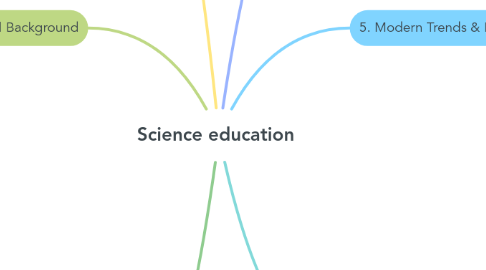
1. 1. Definition & Scope
1.1. Teaching & learning of science
1.2. Covers school children, college students, and the public
1.2.1. Science content
1.2.2. Science process (scientific method)
1.2.3. Social science elements
1.2.4. Teaching pedagogy
1.3. Standards for K-12 and beyond
1.4. Subjects: Physical, Life, Earth, Space, and Human sciences
2. 2. Historical Background
2.1. United Kingdom
2.1.1. William Sharp introduced science in British schools (1850)
2.1.2. BAAS promoted "pure science" (1867)
2.1.3. London School Board (1870) to train science teachers
2.1.4. Key influencers: Thomas Henry Huxley & John Tyndall
2.2. United States
2.2.1. Science education was unstructured before 1890s
2.2.2. Debate: Citizen science vs. Pre-professional training
2.2.3. Committee of Ten (1892) standardized curriculum
2.2.4. Focus: Mental training & college preparation
2.2.5. Project 2061 & AAAS emphasized science-society connections
3. 3. Fields of Science Education
3.1. Physics Education
3.1.1. Study of matter & energy interactions
3.1.2. Physics First initiative (9th grade physics introduction)
3.1.3. Decline in U.S. high school physics education
3.1.4. Technology-enhanced learning for engagement
3.2. Chemistry Education
3.2.1. Study of substances & transformations
3.2.2. Linked to sustainability & environmental issues
3.2.3. Hands-on experiments improve understanding
3.3. Biology Education
3.3.1. Study of living organisms, heredity, and evolution
3.3.2. Emphasis on hands-on laboratory work
3.3.3. Based on Committee of Ten recommendations
3.4. Nature of Science Education
3.4.1. Science as a human initiative
3.4.2. Understanding scientific evolution & societal impact
4. 4. Pedagogy & Teaching Approaches
4.1. Traditional Approach: Rote memorization (criticized)
4.2. Constructivism: Learner-centered, conceptual understanding
4.3. Scientific Teaching (2004)
4.3.1. Active learning (inquiry-based, cooperative)
4.3.2. Diversity (inclusive approaches)
4.4. Guided Discovery Approach (Arthur Koestler)
4.4.1. Students rediscover scientific principles
4.4.2. Promotes creativity & engagement
5. 5. Modern Trends & Innovations
5.1. STEAM (Science, Technology, Engineering, Arts, Mathematics)
5.2. Technology integration in teaching
5.3. Real-world applications in science education
5.4. Diversity & inclusivity in science fields
6. 6. Research in Science Education
6.1. Informed by computer science, cognitive science, psychology, anthropology
6.2. Goals:
6.2.1. Define learning in science
6.2.2. Understand how learning occurs
6.3. Key Research Findings (John D. Bransford et al.)
6.3.1. Preconceptions:
6.3.1.1. Students have strong prior misconceptions
6.3.1.2. Educators must identify & address them
6.3.2. Metacognition:
6.3.2.1. Students should reflect on thinking & learning
6.3.2.2. Helps in evaluating reasoning & problem-solving
6.4. Use of Educational Technologies
6.4.1. Mobile & tech tools increase engagement
6.4.2. Research focus:
6.4.2.1. Physics (64%)
6.4.2.2. Biology (21%)
6.4.2.3. Chemistry (15%)
